Perspectives on Electric Motor Market Transformation for a Net Zero Carbon Economy
Abstract
:1. Introduction
2. Efficiency of Installed Base
- Efficiency impact. Major energy savings (typically in the range 20–30%) are possible when the replacement of the old inefficient motor is made with the optimisation of the whole motor system.
- Efficiency ranking. When considering options for efficiency improvements in a company, motors are considered as low priority compared to other measures, notably due to the fact that the percentage points gain is limited (though absolute electricity saving figures are relevant).
- Higher initial investment. Companies often decide based on initial upfront investment rather than on life cycle costs.
- Lack of awareness about the additional benefits of energy-efficient motors and motor systems. The use of higher-efficiency motors and motor systems bring along benefits, such as lower maintenance due to lower operating temperatures or process improvements, that are often not taken into account in the decision-making process.
- Quick availability. When vital plant equipment fails there is a need for it to be brought on-line again as soon as possible. This means that when a motor fails maintenance staff will take the quickest action in order to keep downtime at a minimum. This often means repairing the motor or replacing it with an old motor in stock. Additionally, repairing a motor is often viewed as being the technically lowest risk option.
- Stocks of old motors. Many sites have stocks of older “salvaged” motors and “new old stock” motors of low efficiency, which are ready to replace a damaged motor and there is a natural tendency to use these “free” motors rather than purchasing new motors.
- Split goals. Different company departments (production, energy, maintenance, commercial, financial, etc.) often have different immediate goals. Sometimes, lack of coordination between different departments, together with the low budgets for energy efficiency projects, may lead to electric motor systems efficiency improvements being disregarded.
- Energy audits. Energy audits are, sometimes, not anchored in the reality of installations, and sometimes do not identify energy savings opportunities in motor systems, leading to recommendations that are not practical or cost-effective to implement.
3. Policy Options
- Raising MEPS levels
- Financial Incentives
- Energy Audit Programs
- Raising Awareness and Information Provision
4. The Role of Advanced Motor Technologies
- Detect if, how much and how long the motor/fan/pump/compressor is operating at suboptimal conditions (low efficiency, stall conditions, frequent on/off switching, vibrations etc.).
- Detect abnormal operation conditions (e.g., leaks in compressed air systems, dirty filters).
- Allow for system integration throughout plants, allowing multiple pieces of machinery to be networked together, optimizing resources.
- Real-time monitoring of the energy consumption of motors. Information can, on the one hand, give a better understanding of how and when the energy is being used and, on the other, provide hints on energy efficiency practices leading to optimization.
5. The Case of the European Union
6. Estimation of Potential Impact of Large-Scale Application of Energy-Efficient Motor Systems
- Assuming an average 4% gain in efficiency, equal to the average difference between IE1 class and IE3 class motors, translates into savings of 25 TWh/year for the full replacement of the old inefficient motors (IE2 and below) still in use today. The savings would be even larger if the replacement is made with the best available technology motors (IE4 or IE5).
- Correct sizing of the motor can reduce energy consumption by up to 5%. Considering a conservative gain of 2% from replacing old motors with appropriately sized new units would bring additional savings of 12 TWh/year.
- Electronic speed control, achieved by equipping motors with VSDs, can also produce large savings, typically in the range 15–35%, in applications with variable load profiles. These applications represent approximately 50% of all applications [10]. CEMEP, the European industry association of motor manufacturers, estimates the market penetration of VSDs to be approximately 45% in 2020 [35]. However, in 2012 VSDs only represented 22% of all motors sold. This means that a large part of existing motors with variable loads, estimated to be around 35%, are still operated under inefficient control methods. If VSDs are installed in these motors alongside motor renovations, and considering an average saving of 25%, the savings would amount to 26 TWh/year.
- Electricity savings from digitisation of electric motors were identified in the Preparatory study for the Ecodesign and Energy Labelling Working Plan 2020–2024 [36] to be in the 5–10% range. If digitisation techniques were applied to the replaced motors additional savings would be in the range of 31 to 63 TWh/year.
7. Conclusions
Author Contributions
Funding
Data Availability Statement
Conflicts of Interest
References
- United Nations. United Nations Framework Convention on Climate Change (UNFCCC), The Paris Agreement; UNFCCC: Paris, France, 2015. [Google Scholar]
- International Energy Agency. Energy Efficiency 2021; IEA Publications: Paris, France, 2021. [Google Scholar]
- Bigano, A.; Ortiz, R.A.; Markandya, A.; Menichetti, E.; Pierfederici, R.; Galarraga, I.; González-Eguino, M. The linkages between energy efficiency and security of energy supply in Europe. In Handbook of Sustainable Energy; Edward Elgar Publishing Ltd.: Northampton, UK, 2013; pp. 60–83. [Google Scholar]
- Cooremans, C. Competitiveness benefits of energy efficiency: A conceptual framework. In ECEEE Summer Study Proceedings; ECEEE: Stockholm, Sweden, 2015. [Google Scholar]
- IEA. World Energy Outlook 2017; IEA Publications: Paris, France, 2017. [Google Scholar]
- IEA. World Energy Outlook 2021; IEA Publications: Paris, France, 2021. [Google Scholar]
- IEA. Net Zero by 2050 A Roadmap for the Global Energy Sector; International Energy Agency: Paris, France, 2021. [Google Scholar]
- IEC 60034-2-1:2014; Rotating Electrical Machines—Part 2–1: Standard methods for determining losses and efficiency from tests (excluding machines for traction vehicles). International Electrotechnical Commission: Vienna, Austria, 2014.
- IEC 60034-30-1:2014; Rotating Electrical Machines—Part 30-1: Efficiency Classes of Line Operated AC Motors (IE Code). International Electrotechnical Commission: Vienna, Austria, 2014.
- De Almeida, A.T.; Fong, J.; Falkner, H.; Bertoldi, P. Policy options to promote energy efficient electric motors and drives in the EU. Renew. Sustain. Energy Rev. 2017, 74, 1275–1286. [Google Scholar] [CrossRef]
- De Almeida, A.T.; Fonseca, P.; Ferreira, F.; Guisse, F.; Blaise, J.; Clair, E.; Diop, A.; Previ, A.; Dominioni, A.C.; Di Pillo, M.; et al. Improving the Penetration of Energy-Efficient Motors and Drives; EU SAVE Programme (Specific Actions for Vigorous Energy Efficiency); Report for the European Commission; European Commission: Brussels, Belgium, 2000. [Google Scholar]
- Waide, P.; Brunner, C.U. Energy-Efficiency Policy Opportunities for Electric Motor-Driven Systems; IEA Energy Papers; OECD Publishing: Paris, France, 2011. [Google Scholar]
- De Almeida, A.T.; Fonseca, P.; Ferreira, F.; Fong, J. Ecodesign Directive Preparatory Study—EuP Lot 11 Motors; ISR-University of Coimbra for the European Commission (DG-TREN): Coimbra, Portugal, 2008. [Google Scholar]
- Werle, R.; Brunner, C.; Tieben, R. Swiss motor efficiency program EASY: Results 2010–2014. In Proceedings of the ACEEE Summer Study on Energy Efficiency in Industry, Buffalo, NY, USA, 4–6 August 2015. [Google Scholar]
- Rao, P.; Sheaffer, P.; Chen, Y.; Goldberg, M.; Jones, B.; Cropp, J.; Hester, J. U.S. Industrial and Commercial Motor System Market Assessment Report Volume 1: Characteristics of the Installed Base; DoE: Washington, DC, USA, 2021. [Google Scholar]
- Motor Study Group. Actions to Promote Energy Efficient Electric Motors; EU SAVE Programme (Specific Actions for Vigorous Energy Efficiency); Report for the European Commission; European Commission: Brussels, Belgium, 1996. [Google Scholar]
- Fleiter, T.; Eichhammer, W. Energy Efficiency in Electric Motor Systems: Technology, Saving Potentials and Policy Options for Developing Countries; United Nations Industrial Development Organization: Vienna, Austria, 2012. [Google Scholar]
- Almeida, A.d.; Falkner, H.; Fong, J. Ecodesign Directive Preparatory Study-Lot 30: Motors and Drives; ISR-University of Coimbra for the European Commission (DG-Energy): Coimbra, Portugal, 2014. [Google Scholar]
- Mahlia, T.M.I.; Yanti, P.A.A. Cost efficiency analysis and emission reduction by implementation of energy efficiency standards for electric motors. J. Clean. Prod. 2010, 18, 365–374. [Google Scholar] [CrossRef]
- Gómez, J.R.; Quispe, E.C.; Castrillón, R.D.P.; Viego, P.R. Identification of Technoeconomic Opportunities with the Use of Premium Efficiency Motors as Alternative for Developing Countries. Energies 2020, 13, 5411. [Google Scholar] [CrossRef]
- Gómez, J.R.; Sousa, V.; Eras, J.J.C.; Gutiérrez, A.S.; Viego, P.R.; Quispe, E.C.; de León, G. Assessment criteria of the feasibility of replacement standard efficiency electric motors with high-efficiency motors. Energy 2022, 239, 121877. [Google Scholar] [CrossRef]
- De Almeida, A.T.; Ferreira, F.J.T.E.; Baoming, G. Beyond Induction Motors—Technology Trends to Move Up Efficiency. IEEE Trans. Ind. Appl. 2014, 50, 2103–2114. [Google Scholar] [CrossRef]
- Heidari, H.; Rassõlkin, A.; Kallaste, A.; Vaimann, T.; Andriushchenko, E.; Belahcen, A.; Lukichev, D.V. A Review of Synchronous Reluctance Motor-Drive Advancements. Sustainability 2021, 13, 729. [Google Scholar] [CrossRef]
- Yilmaz, M. Limitations/capabilities of electric machine technologies and modeling approaches for electric motor design and analysis in plug-in electric vehicle applications. Renew. Sustain. Energy Rev. 2015, 52, 80–99. [Google Scholar] [CrossRef]
- Errigo, A.; Choi, J.-K.; Kissock, K. Techno-economic-environmental impacts of industrial energy assessment: Sustainable industrial motor systems of small and medium-sized enterprises. Sustain. Energy Technol. Assessments 2022, 49, 101694. [Google Scholar] [CrossRef]
- De Almeida, A.; Fong, J.; Brunner, C.; Werle, R.; Van Werkhoven, M. New technology trends and policy needs in energy efficient motor systems—A major opportunity for energy and carbon savings. Renew. Sustain. Energy Rev. 2019, 115, 109384. [Google Scholar] [CrossRef]
- De Almeida, A.; Ferreira, J.T.E.F.; Both, D. Technical and Economical Considerations in the Application of Variable-Speed Drives With Electric Motor Systems. IEEE Trans. Ind. Appl. 2005, 41, 188–199. [Google Scholar] [CrossRef]
- Kulterer, K. Report on the EMSA Survey on Digitalization in Electric Motor Driven Systems; IEA-EMSA: Zurich, Switzerland, 2021. [Google Scholar]
- Håkansson, L.; Höckerman, J. Impact of Digitalization on Electrical Motor Systems; School of Business, Society and Engineering, Mälardalens University: Västerås, Sweden, 2020. [Google Scholar]
- Kulterer, K.; Dawody, J.; van Werkhoven, M.; Widerström, G. Classification of digitalisation technologies for electric motor driven systems. In IEA 4E Electric Motor Systems Annex; IEA Publications: Paris, France, 2022. [Google Scholar]
- European Commission. Commission Regulation (EC) No 640/2009 of 22 July 2009 implementing Directive 2005/32/EC of the European Parliament and of the Council with regard to ecodesign requirements for electric motors. Off. J. Eur. Union 2009, L191, 26. [Google Scholar]
- European Commission. Directive 2009/125/EC of the European Parliament and of the Council of 21 October 2009 establishing a framework for the setting of ecodesign requirements for energy-related products (recast). Off. J. Eur. Union 2009, L285, 10–35. [Google Scholar]
- European Commission. Commission Regulation (EU) 2019/1781 of 1 October 2019 laying down ecodesign requirements for electric motors and variable speed drives pursuant to Directive 2009/125/EC of the European Parliament and of the Council, amending Regulation (EC) No 641/2009. Off. J. Eur. Union 2019, L272, 74–94. [Google Scholar]
- EUROSTAT. Electricity and Heat Statistics. 2022. Available online: https://ec.europa.eu/eurostat/statistics-explained/index.php?title=Electricity_and_heat_statistics (accessed on 12 September 2022).
- CEMEP. Energy Efficiency with Electric Drive Systems; CEMEP: Brussels, Belgium, 2015. [Google Scholar]
- Maagøe, V.; VHK. Preparatory Study for the Ecodesign and Energy Labelling Working Plan 2020–2024; European Commission, DG GROW: Brussels, Belgium, 2021. [Google Scholar]
- IEA. World Energy Outlook 2019; IEA Publications: Paris, France, 2019. [Google Scholar]
- McKinsey & Company. Pathways to a Low Carbon Economy; McKinsey & Company: Mumbai, India, 2013. [Google Scholar]
- Stena Recylcling. An ABB and Stena Recycling Collaboration Towards a More Sustainable Industry. 2019. Available online: https://www.stenarecycling.com/news/an-abb-and-stena-recycling-collaboration-towards-a-more-sustainable-industry/ (accessed on 18 September 2022).
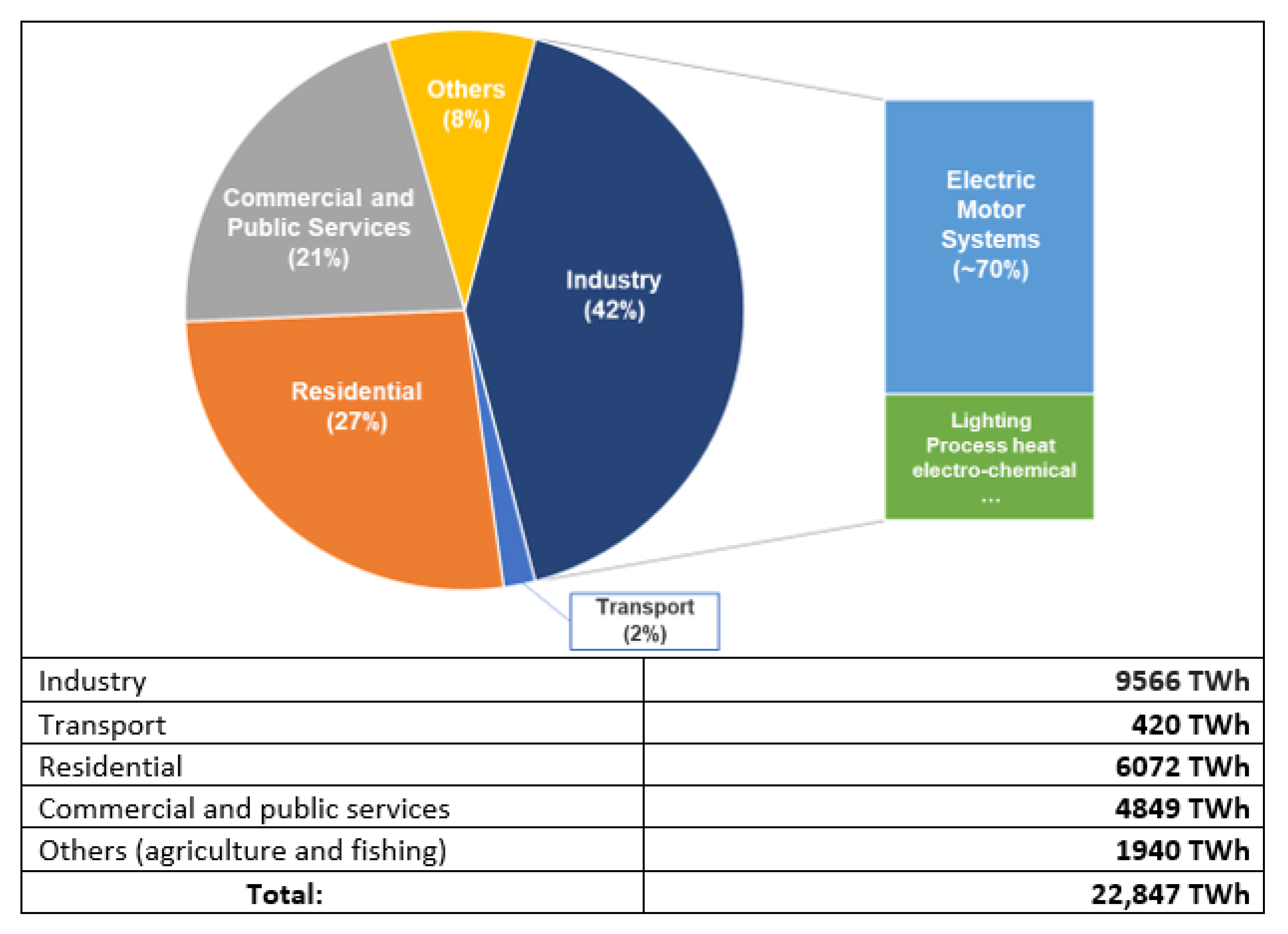

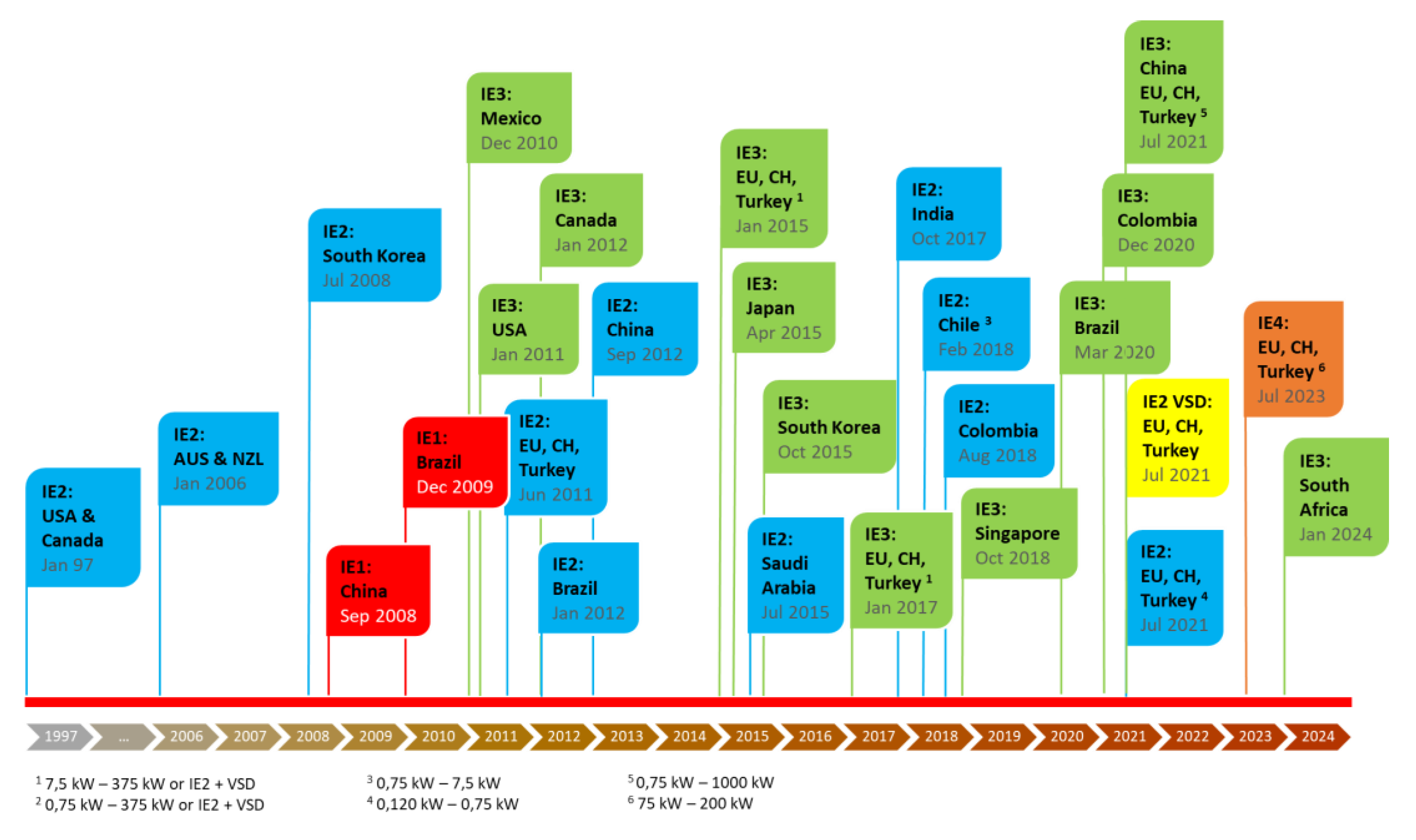


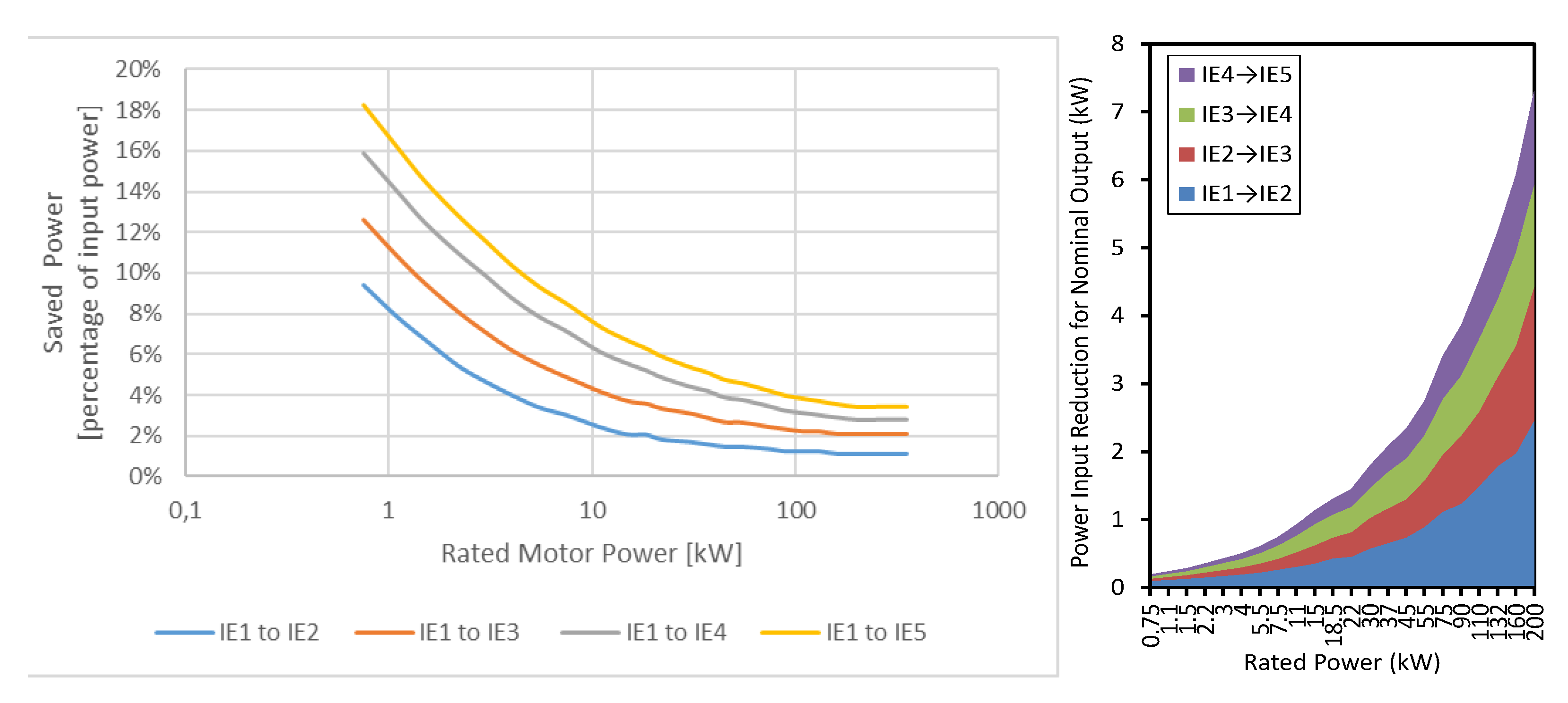
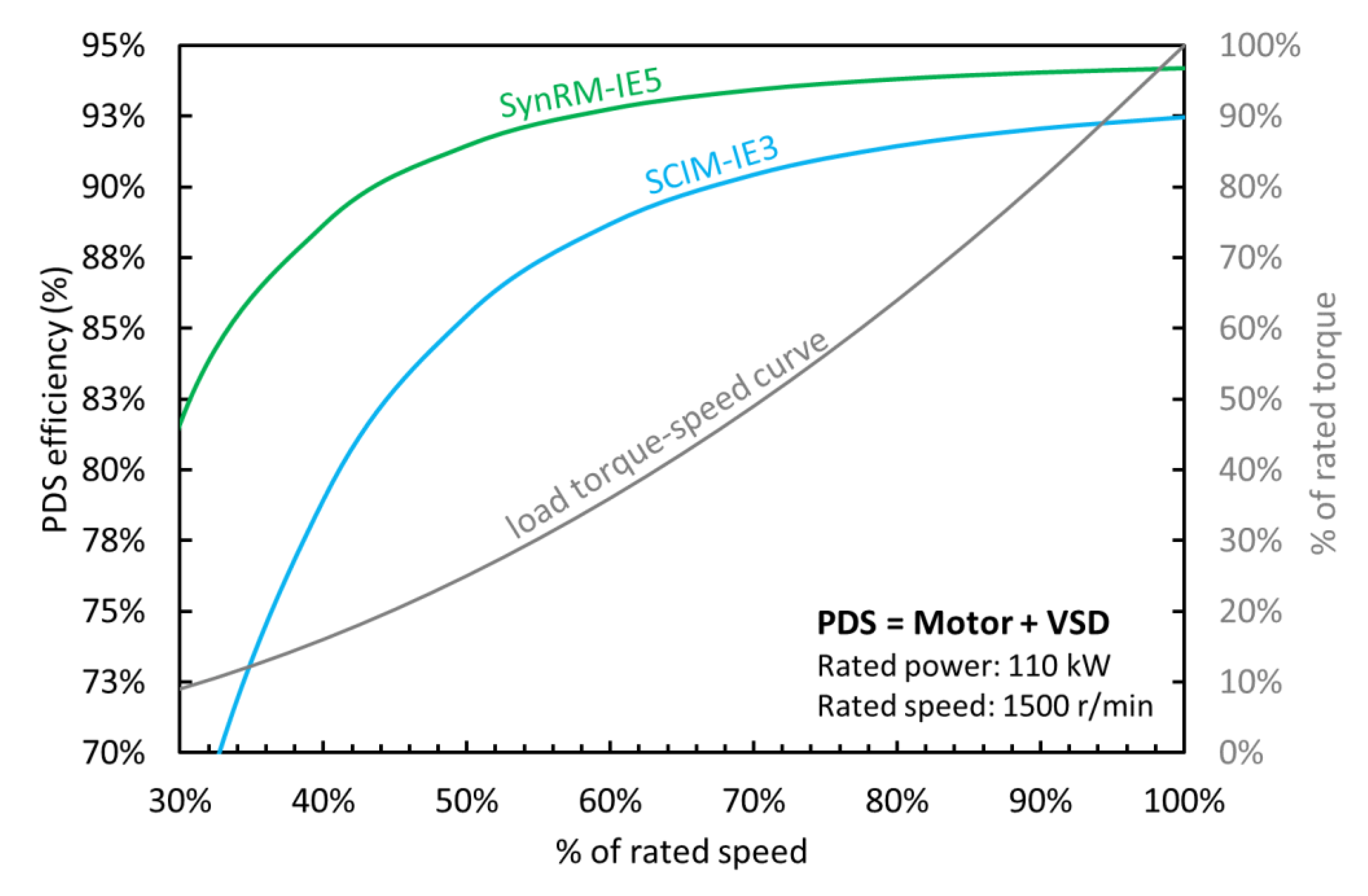
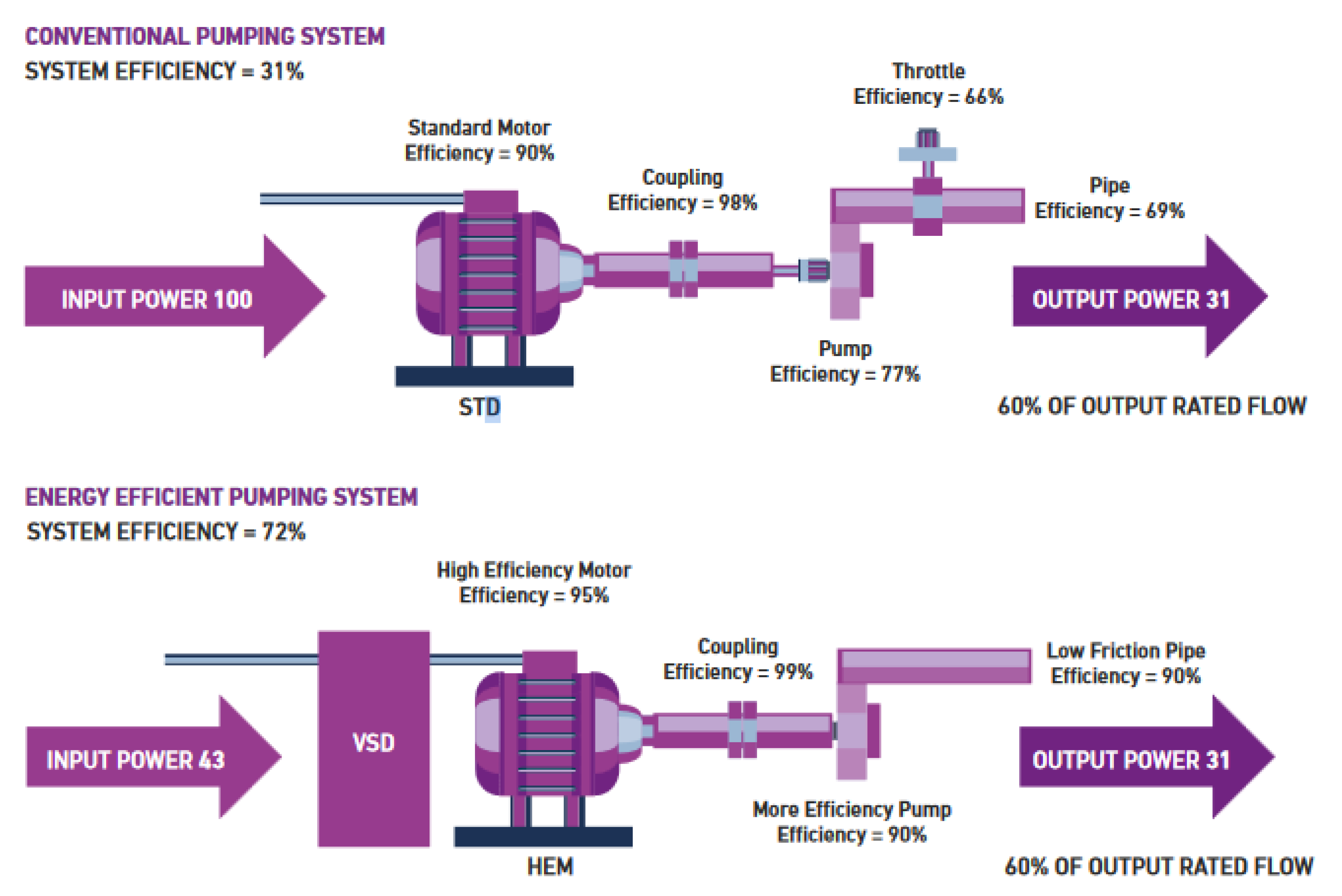

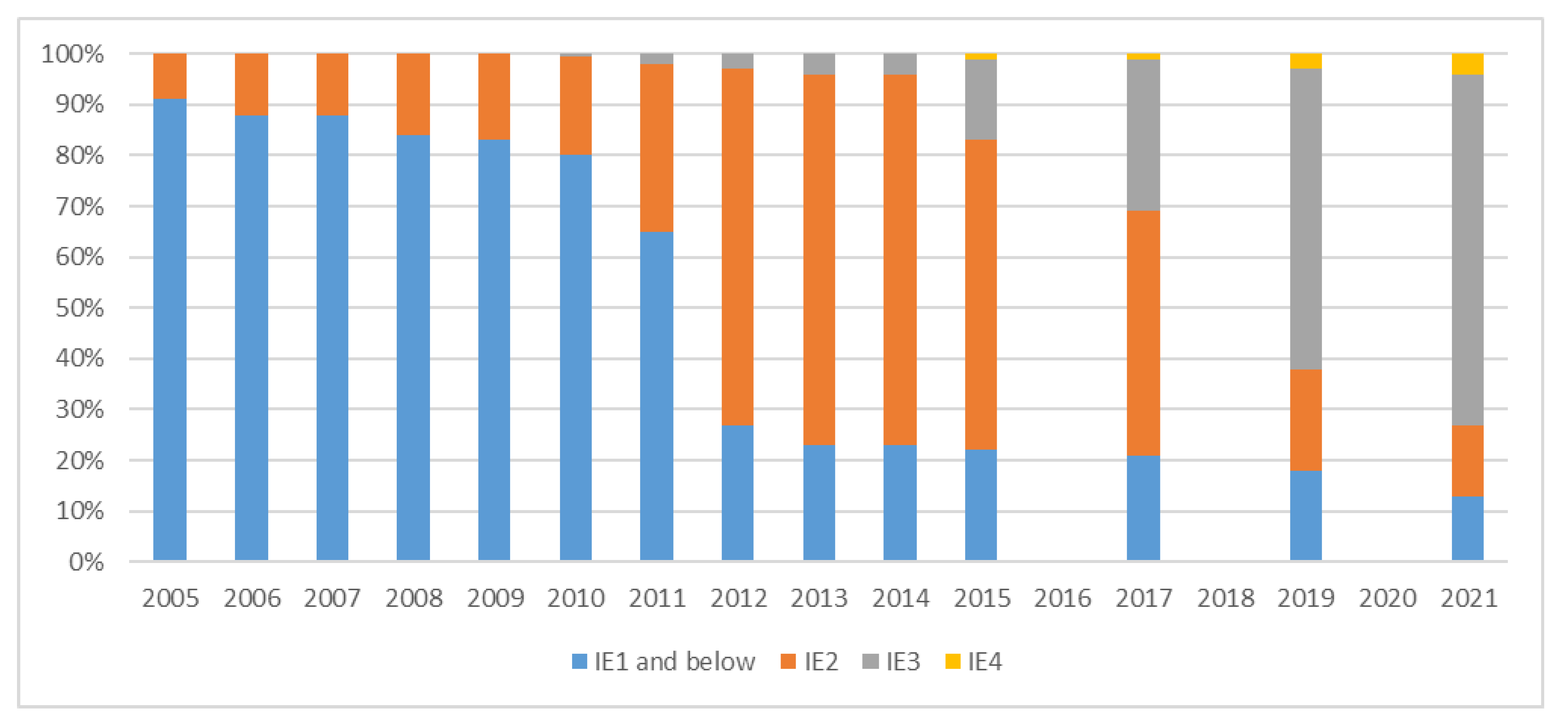
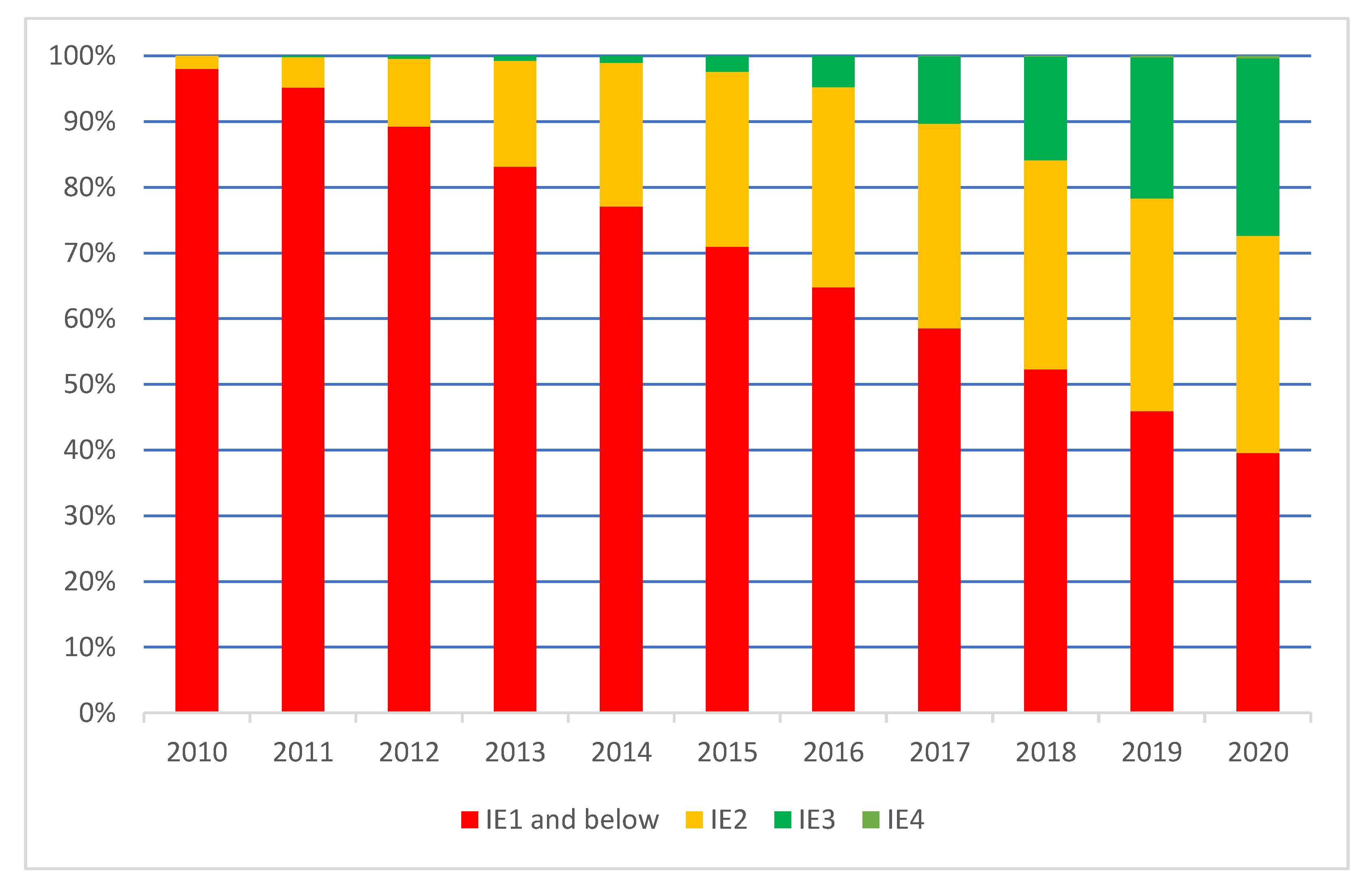
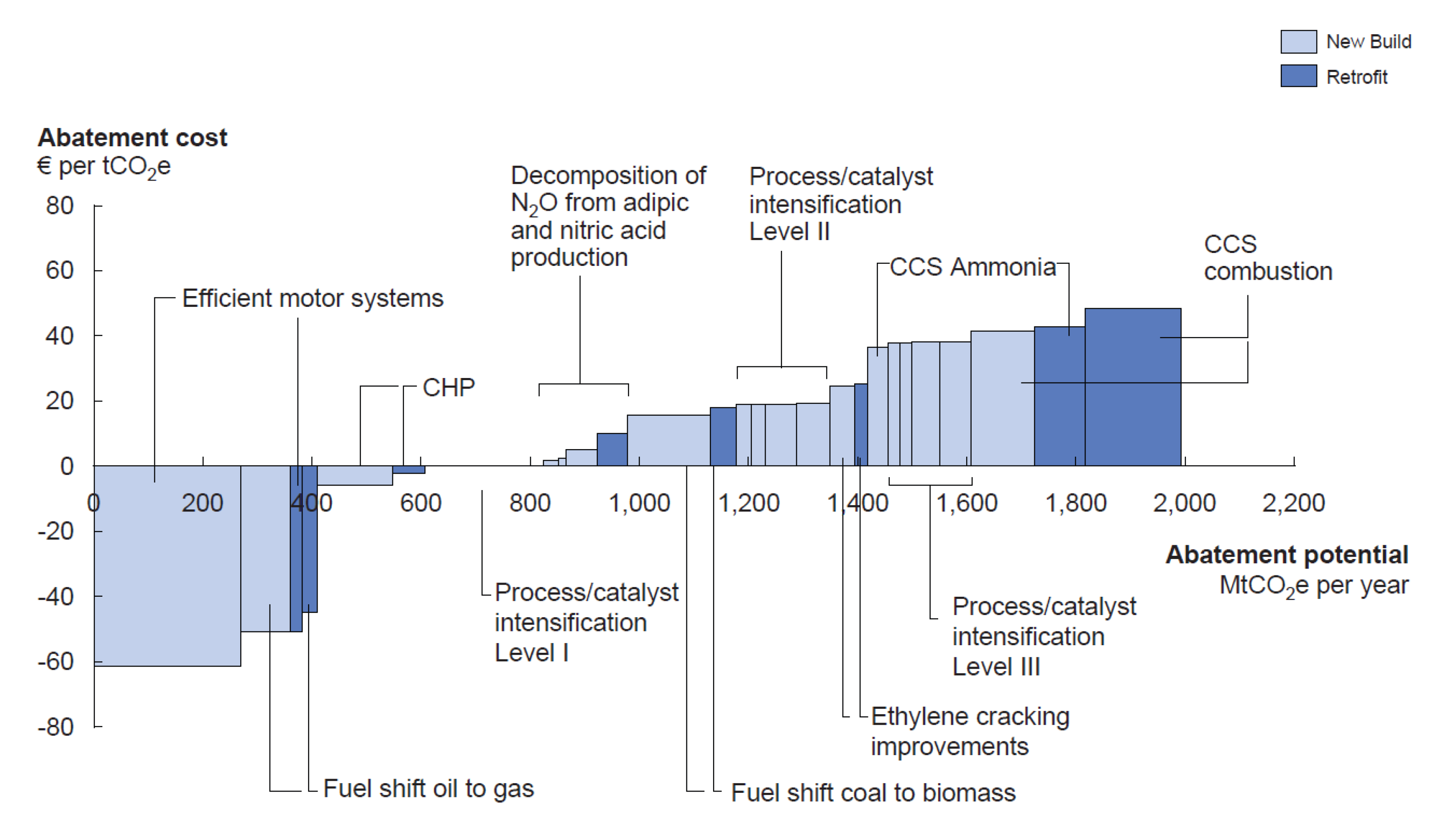
| Indicator/Feature | Self-Cooled Three-Phase Radial-Flux Motor Technology | ||||||||
|---|---|---|---|---|---|---|---|---|---|
| Variable-Speed Applications (Optimized Supply Voltage and Frequency) | Fixed-Speed Applications (Rated Supply Voltage and Frequency) | ||||||||
| SCIM | PMSM | SynRM | PMSynRM | SCIM | Line-Start PMSM | Line-Start SynRM | Line-Start PMSynRM | ||
Cross-sectional topology with identification of active materials:
|  |  |  |  |  |  |  |  | |
| Line-start capability without VSD | yes | no | no | no | yes | yes | yes | yes | |
| Requires VSD | yes | yes | yes | yes | no | no | no | no | |
| Possibility of using an electronic soft-starter or Y-D starter | n.a. | n.a. | n.a. | n.a. | yes | no | no | no | |
| Motor cost | $ | $$$ | $ | $$ | $ | $$$ | $$ | $$ | |
| VSD cost | $ | $ | $$ | $ | n.a. | n.a. | n.a. | n.a. | |
| Rated efficiency of the motor (best available technology) | ••• | ••••• | •••• | •••• | ••• | •••• | ••• | •••• | |
| Typical efficiency class range | IE1–IE4 | IE4–IE5 | IE3–IE5 | IE4–IE5 | IE1–IE4 | IE3–IE4 | IE3–IE4 | IE4–IE5 | |
| Rated power factor of the motor | ••• | •••• | • | ••• | ••• | •••• | • | •••• | |
| Efficiency reduction at partial torque and/or speed | ••• | •••• | •••• | •••• | •• | •••• | ••• | ••• | |
| Motor reliability and robustness | ••••• | •••• | ••••• | •••• | ••••• | •• | ••••• | •• | |
| Power density (kW/kg) for standard frame sizes | •• | ••••• | ••• | •••• | •• | •••• | ••• | •••• | |
| Overload capacity | ••••• | ••• | ••••• | ••• | ••••• | ••• | •••• | ••• | |
| Field weakening | •••• | ••• | ••••• | ••• | n.a. | n.a. | n.a. | n.a. | |
| Very high-speed capability | •••• | ••• | ••••• | ••• | n.a. | n.a. | n.a. | n.a. | |
| Thermal limitations | •••• | •• | ••••• | ••• | •••• | •• | ••••• | ••• | |
| Useful lifetime | ••••• | •••• | ••••• | •••• | ••••• | •••• | ••••• | •••• | |
| Technology maturity | ••••• | •••• | ••• | •• | ••••• | ••• | • | • | |
| Active materials and parts | Electrical steel core | yes | yes | yes | yes | yes | yes | yes | yes |
| Cooper winding | yes | yes | yes | yes | yes | yes | yes | yes | |
| Cooper or aluminum cage | yes | no | no | no | yes | yes | yes | yes | |
| Ferrite PMs in the rotor | no | no | no | yes | no | yes | no | yes | |
| Rare-earth PMs in the rotor | no | yes | no | no | no | yes | no | no | |
Disclaimer/Publisher’s Note: The statements, opinions and data contained in all publications are solely those of the individual author(s) and contributor(s) and not of MDPI and/or the editor(s). MDPI and/or the editor(s) disclaim responsibility for any injury to people or property resulting from any ideas, methods, instructions or products referred to in the content. |
© 2023 by the authors. Licensee MDPI, Basel, Switzerland. This article is an open access article distributed under the terms and conditions of the Creative Commons Attribution (CC BY) license (https://creativecommons.org/licenses/by/4.0/).
Share and Cite
de Almeida, A.T.; Ferreira, F.J.T.E.; Fong, J. Perspectives on Electric Motor Market Transformation for a Net Zero Carbon Economy. Energies 2023, 16, 1248. https://doi.org/10.3390/en16031248
de Almeida AT, Ferreira FJTE, Fong J. Perspectives on Electric Motor Market Transformation for a Net Zero Carbon Economy. Energies. 2023; 16(3):1248. https://doi.org/10.3390/en16031248
Chicago/Turabian Stylede Almeida, Anibal T., Fernando J. T. E. Ferreira, and João Fong. 2023. "Perspectives on Electric Motor Market Transformation for a Net Zero Carbon Economy" Energies 16, no. 3: 1248. https://doi.org/10.3390/en16031248
APA Stylede Almeida, A. T., Ferreira, F. J. T. E., & Fong, J. (2023). Perspectives on Electric Motor Market Transformation for a Net Zero Carbon Economy. Energies, 16(3), 1248. https://doi.org/10.3390/en16031248








